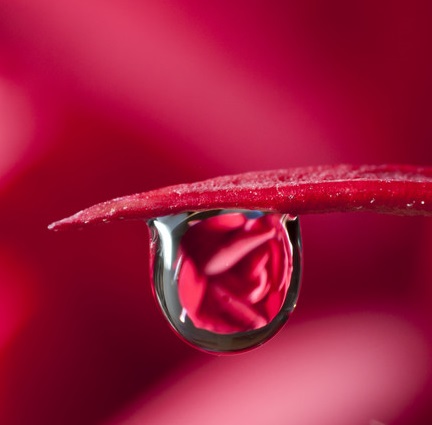Nano-tape for grasping liquid beads
 The structure of a new material created at the University of Sydney manages to mimic the petals of a rose on a nano-scale – capturing beads of water and other liquids across its skin.
The structure of a new material created at the University of Sydney manages to mimic the petals of a rose on a nano-scale – capturing beads of water and other liquids across its skin.
Dr Andrew Telford from the University's School of Chemistry says: “The newly discovered material uses raspberry particles - so-called because of their appearance - which can trap tiny water droplets and prevent them from rolling off surfaces, even when that surface is turned upside down.”
A new study published in the latest edition of the Chemistry of Materials journal says there are virtually innumerable applications possible with the novel creation. According to its inventors the material’s ability to immobilise very small droplets on a surface comes from the same microscopic design as a rose petal that allows water to bead at the top.
“This is a sign the flower is highly water repellent,” Dr Telford said.
The team replicated nature’s design by stacking a series of spherical micro- and nanoparticles. Water droplets were observed to bead-up on films of the raspberry particles and are not able to drip down from it even when the film is turned upside-down.
“Raspberry particle films can be described as sticky tape for water droplets,” Dr Telford said.
Some suggested applications include ending condensation on aircraft windows, as well as rapidly increasing the speed and cost-effectiveness of medical test conducted on small amounts of fluid. Researchers say the nano-tape has the potential for very high turnover of tests in remote areas with inexpensive equipment.
There are many more benefits from the broader design of the tape, with researchers now tweaking the formula to create new variations.
“This means we will be able to design a surface that does whatever you need it to do,” Dr Telford said
“We could also design a surface that stays dry forever, never needs cleaning or able to repel bacteria or even prevent mould and fungi growth. We could then tweak the same structure by changing its composition so it forces water to spread very quickly.”
"This could be used on quick-dry walls and roofs which would also help to cool down houses... this can only be achieved with a very clear understanding of the science behind the chemical properties and construction of the surface,” he explained.
The other research team members and journal authors are Associate Professor Brian Hawkett and Dr Chiara Neto, both from the School of Chemistry and Dr Chris Such from Dulux Australia, that supported the research through an Australian Research Council Linkage Project grant.
"Our team's discovery is the first that allows for the preparation of raspberry particles on an industrial scale and we are now in a position where we can prepare large quantities of these particles without the need to build special plants or equipment," Dr Telford said.








 Print
Print